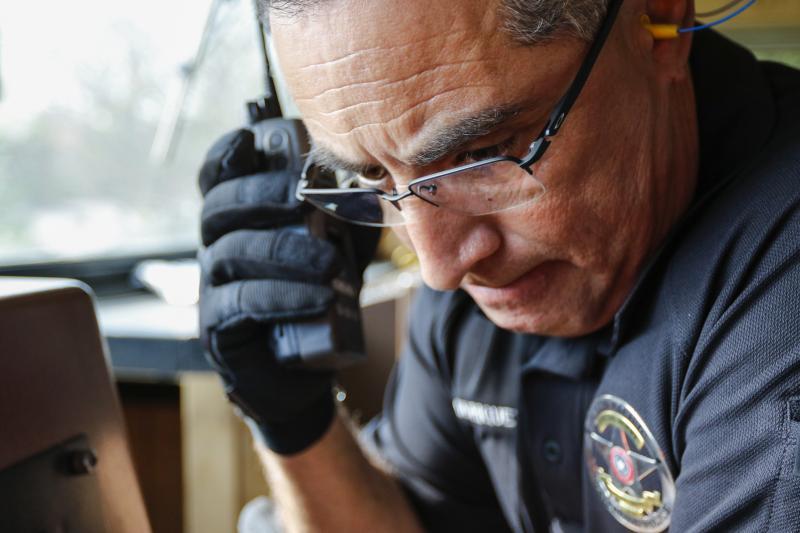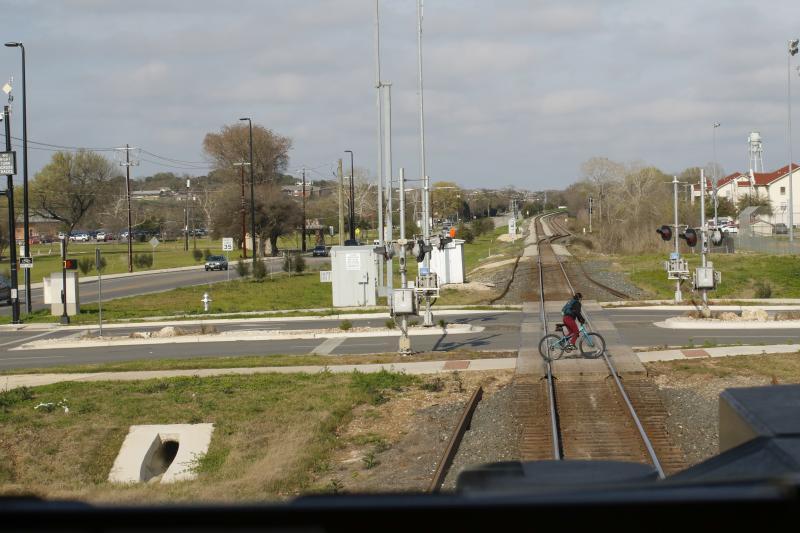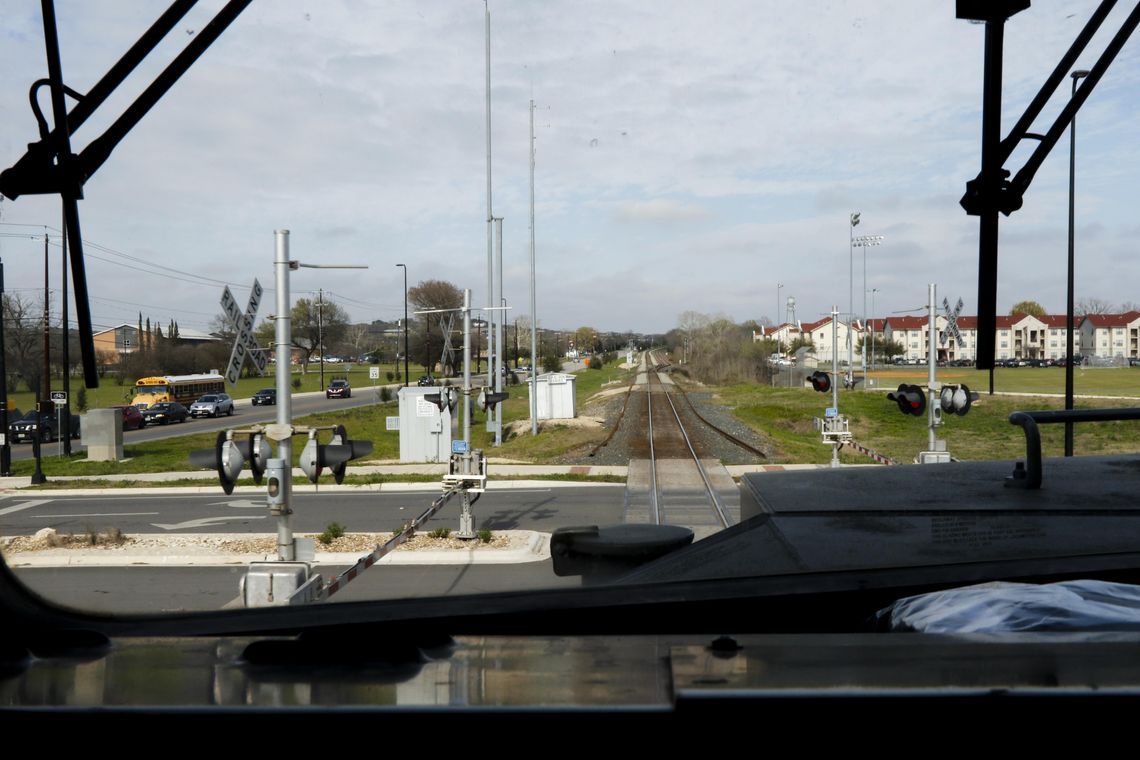With more than 30 trains per day passing through San Marcos (according to the city website) and more than a dozen railroad crossings in town, there are plenty of opportunities to choose between risking lives or playing it safe when a train is coming. On Tuesday, Union Pacific Police and local law enforcement officers teamed up to see what kind of behavior drivers, bicyclists and pedestrians engage in once the lights start flashing at railroad crossings in San Marcos.
Special Agent Alfredo Rodriguez with the Union Pacific Police rode along the tracks in San Marcos with locomotive engineer Martin Fluitt and conductor Paul Rockowitz at the helm. Rodriguez communicated with local police officers stationed near railroad crossings whenever he saw someone breaking the law. Daily Record staff were allowed to ride along with Rodriguez.
Almost immediately after the locomotive pulled away from the Amtrak platform just south of the Guadalupe Street crossing, Rodriguez saw motorists racing the crossing arms. Two cars went across the LBJ Street crossing while the bars lowered. One pedestrian walked briskly across the tracks at Hopkins Street near the river after the lights began flashing.
“Sometimes we’ll have kids running across, like that one, trying to get to class,” Rodriguez said.
Rodriguez’s ride on Tuesday was an operation that’s part of Union Pacific’s UP CARES (Crossing Accident Reduction, Education and Safety) program. As implied by its name, the program aims to encourage safe behavior at railroad crossings and educate the public about safety. When Rodriguez alerted local police officers of drivers or pedestrians who failed to stop at crossings when the lights were flashing, officers stopped drivers and approached pedestrians to remind them to follow the laws designed to keep them safe at train crossings. Officers issued citations if an infraction was deemed severe enough.
Education about railroad crossing safety went beyond reminding motorists of the law, however, Rodriguez was slated to give a safety presentation to city staff on Wednesday, and he said Union Pacific arranges to hold presentations for law enforcement agencies and anyone else who has to deal with railroad crossing safety on a regular basis.
Rodriguez said that every three hours, a person or vehicle in the United States is hit by a train. The UP CARES program has been going since 1972, he said, “And people are still being hit by a train every three hours.”
According to the Federal Railroad Administration, in 2017 there were 274 highway-rail grade crossing fatalities in the United States; 13 of those were in Texas. Also in 2017, there were 1,080 pedestrian rail trespass casualties (fatalities and injuries) across the country; in Texas, there were 41 deaths and 52 injuries.

Senior Special Agent Alfredo Rodriguez listens to officers on the ground from inside the train’s cab as San Marcos Police and railroad officers were on the lookout for violations.
‘That means stop’
When asked what the dumbest thing was that he’d ever seen someone do at a railroad crossing, Rodriguez replied, “Just trying to beat the train,” including going around the bars that are supposed to keep cars from crossing when a train approaches.
“Once the lights are on, universally, that means stop,” he said. “It doesn’t mean go faster.”
Simply paying attention at railroad crossings can help drivers make safe decisions. The “quiet zone” that runs through most of San Marcos — Fluitt said he can ring the bell but not blow the horn in that zone — makes it even more important for drivers to pay attention to the lights and the crossing bars and to slow down and look to see if a train is coming.
One train engine alone can weigh more than 400,000 pounds. Physics dictates that something that heavy cannot stop quickly. Rodriguez said that it can take a train traveling 55 miles per hour more than a mile to stop, which is why law grants trains the right-of-way on railroad tracks.
When a train crew sees someone on the tracks ahead, Rodriguez said, “All they can do is apply the brakes, blow the horn and hope the people get out of the way.”
One such instance occurred during Rodriguez’s ride on Tuesday when two people on bicycles looked directly at the train and, despite Fluitt’s repeatedly blowing the horn to warn them, continued across the tracks at the crossing on Aquarena Springs Drive near Post Road.
Rodriguez alerted local police to the bicyclists and noted how dangerous it was that they continued across when the train was so close. There is a gap between the pavement and the rails, he said, and if a bicycle tire gets caught up because of the gap, the bike could flip, leaving it and its rider on the tracks.
“We would have been hitting them,” he said, even though the engine was only going 25 miles an hour. “We can’t stop quickly.”
Pedestrians also face danger at railroad crossings and walking along railroad tracks. Designated vehicle or pedestrian crossings are the only legal areas for walking across tracks, Rodriguez said; otherwise, pedestrians can face trespassing charges.

A cyclist pedals across the tracks after going around the crossing arms, the second of two to do so in plain sight.
Safety steps
The U.S. Department of Transportation and Federal Motor Carrier Safety Administration has a flyer listing safety tips for approaching railroad crossings. Most of the steps involve simply approaching crossings with care and looking and listening for an approaching train. Drivers are also reminded not to stop on the railroad tracks.
“If it won’t fit, don’t commit,” the safety flyer reads. “Do not enter a crossing unless you can drive completely through without stopping.”
Moreover, the flyer said, trains are wider than the tracks, so drivers should leave enough space that their vehicles are at least 6 feet past the furthest rail.
The flyer also includes steps to take if your vehicle stalls or hangs up on the tracks. The first step is to get out of the vehicle. Next, move away from the vehicle; if a train is coming, walk toward the oncoming train and away from the tracks at a 45-degree angle to avoid flying debris if your vehicle is hit. Next, find the railroad’s emergency phone number located on a sign near the crossing (sometimes posted below the flashing lights or on a metal signal box nearby). The signs will also have the crossing identification number that you should give to authorities when you call for help. Besides calling the railroad, you can also call local police or 911 and tell them a vehicle is on the tracks.







